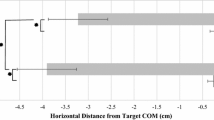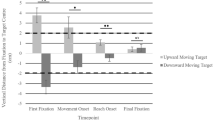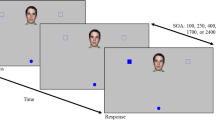Abstract
Grasping moving objects involves both spatial and temporal predictions. The hand is aimed at a location where it will meet the object, rather than the position at which the object is seen when the reach is initiated. Previous eye–hand coordination research from our laboratory, utilizing stationary objects, has shown that participants’ initial gaze tends to be directed towards the eventual location of the index finger when making a precision grasp. This experiment examined how the speed and direction of a computer-generated block’s movement affect gaze and selection of grasp points. Results showed that when the target first appeared, participants anticipated the target’s eventual movement by fixating well ahead of its leading edge in the direction of eventual motion. Once target movement began, participants shifted their fixation to the leading edge of the target. Upon reach initiation, participants then fixated towards the top edge of the target. As seen in our previous work with stationary objects, final fixations tended towards the final index finger contact point on the target. Moreover, gaze and kinematic analyses revealed that it was direction that most influenced fixation locations and grasp points. Interestingly, participants fixated further ahead of the target’s leading edge when the direction of motion was leftward, particularly at the slower speed—possibly the result of mechanical constraints of intercepting leftward-moving targets with one’s right hand.




Similar content being viewed by others
References
Brenner E, Smeets JBJ (2007) Flexibility in intercepting moving objects. J Vision 7:1–7. doi:10.1167/7.5.14
Brenner E, Smeets JBJ (2009) Sources of variability in interceptive movements. Exp Brain Res 195:117–133. doi:10.1007/s00221-009-1757-x
Brenner E, Smeets JBJ (2011) Continuous visual control of interception. Hum Mov Sci 30:475–494. doi:10.1016/j.humov.2010.12.007
Brouwer A, Franz VH, Gegenfurtner KR (2009) Differences in fixations between grasping and viewing objects. J Vision 9:1–24. doi:10.1167/9.1.18
Daye PM, Blohm G, Lefèvre P (2014) Catch-up saccades in head-unrestrained conditions reveal that saccade amplitude is corrected using an internal model of target movement. J Vision 14:1–18. doi:10.1167/14.1.12
De Brouwer S, Yuksel D, Blohm G, Missal M, Lefèvre P (2002) What triggers catch-up saccades during visual tracking? J Neurophysiol 87:1646–1650. doi:10.1152/jn.00432.2001
De Grave DDJ, Hesse C, Brouwer A, Franz VH (2008) Fixation locations when grasping partly occluded objects. J Vision 8:1–11. doi:10.1167/8.7.5
Desanghere L, Marotta JJ (2008) Gaze strategies while grasping: what are you looking at?! J Vision 8:495. doi:10.1167/8.6.299
Desanghere L, Marotta JJ (2011) “Graspability” of objects affects gaze patterns during perception and action tasks. Exp Brain Res 212:177–187. doi:10.1007/s00221-011-2716-x
Goodale MA, Jakobson LS, Keillor JM (1994) Differences in the visual control of pantomimed and natural grasping movements. Neuropsychologia 32:1159–1178
Hayhoe M, Ballard D (2005) Eye movements in natural behavior. Trends Cognit Sci 9:188–194. doi:10.1016/j.tics.2005.02.009
Hayhoe MM, Shrivastava A, Mruczek R, Pelz JB (2003) Visual memory and motor planning in a natural task. J Vision 3:49–63. doi:10.1167/3.1.6
Henderson JM (2003) Human gaze control during real-world scene perception. Trends Cognit Sci 7:498–504. doi:10.1016/j.tics.2003.09.006
Johansson RS, Westling G, Bäckström A, Flanagan JR (2001) Eye-hand coordination in object manipulation. J Neurosci 21:6917–6932
Króliczak G, Cavina-Pratesi C, Goodman DA, Culham JC (2007) What does the brain do when you fake it? An FMRI study of pantomimed and real grasping. J Neurophysiol 97:2410–2422. doi:10.1152/jn.00778.2006
Kwok RM, Braddick OJ (2003) When does the Titchener circles illusion exert an effect on grasping? Two- and three-dimensional targets. Neuropsychologia 41:932–940. doi:10.1016/S0028-3932(02)00324-X
Lòpez-Moliner J, Brenner E (2014) When must one look at the ball in order to be able to catch it? J Vision 14:843. doi:10.1167/14.10.843
Lòpez-Moliner J, Brenner E, Louw S, Smeets JBJ (2010) Catching a gently thrown ball. Exp Brain Res 206:409–417. doi:10.1007/s00221-010-2421-1
McGowan JW, Kowler E, Sharma A, Chubb C (1998) Saccadic localization of random dot targets. Vision Res 38:895–909. doi:10.1016/S0042-6989(97)00232-0
Melcher D, Kowler E (1999) Shapes, surfaces and saccades. Vision Res 39:2929–2946. doi:10.1016/S0042-6989(99)00029-2
Mennie N, Hayhoe M, Sullivan B (2007) Look-ahead fixations: anticipatory eye movements in natural tasks. Exp Brain Res 179:427–442. doi:10.1007/s00221-006-0804-0
Mrotek LA, Soechting JF (2007) Target interception: hand–eye coordination and strategies. J Neurosci 27:7297–7309. doi:10.1523/JNEUROSCI.2046-07.2007
Murphy BJ (1978) Pattern thresholds for moving and stationary gratings during smooth eye movement. Vision Res 18:521–530. doi:10.1016/0042-6989(78)90196-7
Oldfield RC (1971) The assessment and analysis of handedness: the Edinburgh inventory. Neuropsychologia 9:97–113. doi:10.1016/0028-3932(71)90067-4
Prime SL, Marotta JJ (2013) Gaze strategies during visually-guided versus memory-guided grasping. Exp Brain Res 225:291–305. doi:10.1007/s00221-012-3358-3
Rashbass C (1961) The relationship between saccadic and smooth tracking eye movements. J Physiol 159:326–338
Richtsfeld M, Vincze M (2011) Robotic grasping of unknown objects. In: Goto S (ed) Robot arms. InTech, Rijeka, Croatia, pp 123–136
Salvucci DD, Goldberg JH (2000) Identifying fixations and saccades in eye-tracking protocols. Proceedings of the eye tracking research and applications symposium. ACM Press, New York, pp 71–78
Schlicht EJ, Schrater PR (2007) Effects of visual uncertainty on grasping movements. Exp Brain Res 182:47–57. doi:10.1007/s00221-007-0970-8
Schütz AC, Souto D (2011) Adaptation of catch-up saccades during the initiation of smooth pursuit eye movements. Exp Brain Res 209:537–549. doi:10.1007/s00221-011-2581-7
Smeets JBJ, Hayhoe MM, Ballard DH (1996) Goal-directed arm movements change eye-head coordination. Exp Brain Res 109:434–440
Soechting JF, Flanders M (2008) Extrapolation of visual motion for manual interception. J Neurophysiol 99:2956–2967
Todd JT (1981) Visual information about moving objects. J Exp Psychol Hum Percept Perform 7:795–810. doi:10.1037/0096-1523.7.4.795
Tresilian JR, Plooy AM, Marinovic W (2009) Manual interception of moving targets in two dimensions: performance and space-time accuracy. Brain Res 1250:202–217. doi:10.1016/j.brainres.2008.11.001
Vingerhoets G (2014) Contribution of the posterior parietal cortex in reaching, grasping, and using objects and tools. Front Psychol 5:151. doi:10.3389/fpsyg.2014.00151
Vishwanath D, Kowler E (2004) Saccadic localization in the presence of cues to three-dimensional shape. J Vision 4:445–458. doi:10.1167/4.6.4
Westwood DA, Danckert J, Servos P, Goodale MA (2002) Grasping two-dimensional images and three-dimensional objects in visual-form agnosia. Exp Brain Res 144:262–267. doi:10.1007/s00221-002-1068-y
Acknowledgments
This research was supported by the Undergraduate Student Research Award (USRA) from the Natural Science and Engineering Research Council of Canada (NSERC) and the University of Manitoba’s Undergraduate Research Award held by M.C.B, and a grant from NSERC held by J.J.M. Special thanks are due to Amir Meghdadi for his programming support.
Author information
Authors and Affiliations
Corresponding author
Ethics declarations
Ethical standard
All procedures performed in studies involving human participants were in accordance with the ethical standards of the institutional and/or national research committee and with the 1964 Helsinki Declaration and its later amendments or comparable ethical standards.
Electronic supplementary material
Below is the link to the electronic supplementary material.
Supplementary material 1 (WMV 731 kb)
Rights and permissions
About this article
Cite this article
Bulloch, M.C., Prime, S.L. & Marotta, J.J. Anticipatory gaze strategies when grasping moving objects. Exp Brain Res 233, 3413–3423 (2015). https://doi.org/10.1007/s00221-015-4413-7
Received:
Accepted:
Published:
Issue Date:
DOI: https://doi.org/10.1007/s00221-015-4413-7




